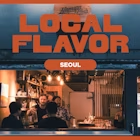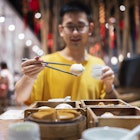

Explore Seoul’s most atmospheric neighborhoods © Pakawat Thongcharoen / Shutterstock
After you’ve taken in the ultra-modern landmarks of central Seoul, make like a local and head to one of the city’s vibrant neighborhoods to unwind.
Away from the bustle of business and tourists, these districts in the South Korean capital brim with lovely cafes, delicious restaurants and off-the-beaten-path historic sites. In these smaller slices of a huge city, you can expect to make a deeper connection with Seoul and Seoulites.
Whether exploring small alleyways in Bukchon or dog-spotting in Yeonnam-dong, you’re certain to love the following areas. Here are the best neighborhoods in Seoul.
Soak up the historic Korean atmosphere in Bukchon Hanok Village
Nestled between Gyeongbokgung and Changdeokgung palaces, Bukchon Hanok Village is a popular tourist destination that’s fully worth the hype. Once you’re strolling along the streets filled with hanok (traditional Korean houses) – a budget-friendly activity in a pricey city – it doesn’t take long to realize why Seoulites recommend this place so ardently, and why it continues to charm all who visit.
The authorities say that the more than 900 hanok homes here offer the best representation of Seoul’s 600-year-old urban history. While the buildings are almost entirely reconstructed or full-on replicas, you will feel like you’re in another time when you wander this area. In recent years, that atmosphere has been accentuated by the popularity of borrowing hanbok (traditional Korean gowns) for photo walks.
Visit during the week to avoid the crowds. Start by grabbing a map of the neighborhood from Bukchon Traditional Culture Center, which pinpoints great photo-taking spots. Then, wander down quiet alleyways filled with small cafes and tea shops that don’t make it into the guidebooks or travel blogs, venturing away from large groups and into Korea’s past.

If you like dogs, you’ll love Yeonnam-dong
An estimated six million households in South Korea have dogs, and one of the top places to see them living their best lives is in Yeonnam-dong, a neighborhood northwest of Hongdae that’s full of dog-friendly spaces.
Start your dog-spotting journey at Gyeongui Line Forest Park. This green space was built on top of railroad tracks that once extended to North Korea; today, it’s popular with both the two- and four-legged residents of the neighborhood. In the grassy area outside Hongik University Station Exit 3, you’ll see humans enjoying a bit of day-drinking and dogs of all sizes, shapes and fashion styles (it’s common for dogs to wear clothes in South Korea).
Indoor spots like the taco joint High House, brunch eatery Grain and the Hongdae branch of vegan restaurant Plant are just a few of the many places that welcome dogs in Yeonnam-dong. Some, like Gelateria Eta and Thanks Oat, even have canine-specific items on the menu. A few dog-friendly cafes, like Oui Oui Club and Bite Me, have clothes and accessories you can take as souvenirs to your puppy pal waiting for you at home.

Discover cool bars and traditional dried fish in Euljiro
From bars lit with a neon glow to hidden places tucked behind unassuming doors, Euljiro has so many cool spaces that locals call it “Hip-jiro.” The evolution (or gentrification) of this neighborhood started around 2015, when younger people began renting out spaces in a district full of warehouses, electronics shops and printing presses.
One of first newcomers was Seendosi (which means “new city”), a laid-back, independent bar that extends from the 4th floor to a 5th-floor rooftop. Since few spaces like this existed in this part of Seoul when it opened, visiting used to mean walking into a dark neighborhood and climbing up four flights of stairs in an empty warehouse before reaching Seendosi’s dim pink ambiance and alternative music.
Seendosi has added more lights since then, and the area is now teeming with bars following a similar formula of industrial chic. Owned by a group of 10 friends, 1/10 is a wine bar marked only by simple sign with “wine” written out in red tape. Eulji-Maekok (Euljiro Brewing) is a two-story craft beer pub with fun illustrations of partying cats and excellent drinks. For those who prefer a more down-to-earth vibe, Nogari Alley brims with old-school Korean pubs that sell local beer and nogari (dried pollock fish), with seats often spilling out onto the streets.
Creative types should flock to Seongsu-dong
Many call Seongsu-dong the Brooklyn of Seoul – yet before younger generations moved in, the neighborhood was known as the go-to place for shoes, home to 70% of the nation’s handmade shoe manufacturers. While this part of town still has a few dozen shops dedicated to custom footwear, art galleries, cafes and vintage clothing boutiques now occupy many of the converted warehouses.
One of the first spaces to attract attention to the area was Daelim Changgo, a cafe and art gallery outfitted in a former factory-warehouse. Cafes like Onion, Grandpa Factory and Dorrell Coffee later replicated the warehouse-conversion formula, and the uptick in artsy types gave birth to a vibrant street art and gallery scene.
Have a cup of coffee and check out Collast, Art Project CO and Kabinett, three talked-about galleries where contemporary Korean art is front and center. The Seongsu-dong art scene is focused on up-and-coming, experimental artists, and the vibe is much more chilled than what you’ll find in better-known neighborhoods of Seoul, such as Gangnam. Bring your camera for fun shots of street art, get caffeinated at one of the many cafes and gallery-hop to your heart’s content. Buying new shoes is optional.

Head to leafy Seongbuk-dong to slow down your pace
A short bus ride from Hansung University Station, Seongbuk-dong is a relatively quiet hillside district lesser known to visitors. The neighborhood once housed refugees and lower-income families after the Korean War; today, it’s better known for its wealth of diplomatic residences and upscale homes. (It’s implied that the fancy house from the 2019 film Parasite is located here.)
Seongbuk-dong feels distinctly different from other parts of the city since it’s not as dense, and its proximity to both Bugaksan and Bukhansan mountains makes the greenery of the slopes visible from most corners of the neighborhood.
The area has several often overlooked attractions, many of which allow you to take a breather from the bustle of typical Seoul life. At Gilsang-sa Temple, consider a Templestay program, a cultural experience that immerses you in traditional Korean Buddhism. Activities include conversations with Buddhists, tea time and sometimes overnight stays. Nearby, you can drink Korean tea at Suyeon Sabang in a space that was once a poet’s house.
Uphill, Manhae Han Yong-un Simujang used to be the home of Buddhist reformist and poet Han Yong-un. Now owned by the Korean government, the house is open to the public and offers glimpses into the famous writer’s life. Because it’s not an official museum, it doesn’t have guards, and there’s little foot traffic. Visitors can simply enter, take off their shoes and relax in the same room where the poet took naps – making it the perfect place to enjoy the quiet of the hillside.
Explore related stories

Tips & Advice
Japan vs South Korea: which impressive East Asian destination should you visit?Nov 19, 2024 • 8 min read








 Food10 of the world’s best foodie destinations (and what to eat when you get there)
Food10 of the world’s best foodie destinations (and what to eat when you get there)Mar 1, 2024 • 12 min read
